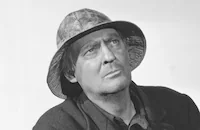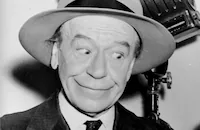The Return of Peter Grimm

Brief Synopsis
Cast & Crew
George Nicholls Jr.
Lionel Barrymore
Helen Mack
Edward Ellis
Donald Meek
George Breakston
Film Details
Technical Specs

Synopsis
Willful, proud Peter Grimm, a prosperous nursery owner in upstate New York, argues constantly with his physician and family friend, Dr. Andrew Macpherson, about reincarnation, insisting that the hereafter does not consist of ghosts who return to visit the living. When Peter learns later that he has a terminal illness, he makes his ward Catherine promise that she will marry his nephew Frederik, even though he knows that she is in love with James, his secretary. Shortly after, Peter dies, and in spite of her growing mistrust of Frederik, Catherine proceeds with the promised wedding plans. Although the scheming Frederik, who believes that Peter has left him his entire estate, is confident that Catherine will keep her vow, a ghostly, remorseful Peter returns to earth, determined to stop the marriage. Unable to communicate with either Catherine, James or Dr. Macpherson, however, Peter goes to the deathbed of William, his housekeeper's sickly grandson. Through William, Peter extracts a confession from Frederik that he is William's father and that years before in Europe, he deserted both the boy and his mother, who later committed suicide. Convinced of Frederik's duplicity, Catherine rejects Frederik and embraces the faithful James, just as Dr. Macpherson locates Peter's will in which he states his intention to leave everything to his ward and "her husband." A satisfied Peter then returns to heaven, with little William at his side.

Director
George Nicholls Jr.
Cast

Lionel Barrymore
Helen Mack

Edward Ellis

Donald Meek
George Breakston
Allen Vincent
James Bush
Ethel Griffies

Lucien Littlefield
Greta Meyer
Ray Mayer
Crew
Lucien Andriot
Sturges Carne
Alberto Colombo
Doran Cox
George D. Ellis
Francis Edwards Faragoh
Kenneth Macgowan
Elizabeth Mcgaffey
Walter Plunkett
Van Nest Polglase
Arthur Schmidt

Videos
Movie Clip



Film Details
Technical Specs

Articles
The Return of Peter Grimm
Belasco was one of Broadway's most successful theatre artists, working in theatres bearing his name at two different times in his career (the later one is still in use today). He was a pioneer in realistic effects, particularly in the realm of lighting, and a noted star maker, working his magic not just on father and son Barrymores, but also on Mrs. Leslie Carter, Blanche Bates, George Arliss, Ina Claire and Mary Pickford. Never one to shy away from big issues, he tackled interracial marriage in Madame Butterfly and prostitution in Zaza. For his 1911 The Return of Peter Grimm he told the story of a man returning after death to contemplate the world he has left behind and attempt to correct the errors he had made in his lifetime. In particular, he discovers that he has entrusted his adopted daughter and nursery business to his nephew Frederick, a shallow schemer out to use them both. Although nobody but a dying child can see him, the ghostly Peter tries to prevent the marriage and get his estate into the right hands. The play ran for 231 performances with David Warfield as Peter. To depict Peter's return from the dead, the play used only the simplest effects. Warfield played his post-death scenes in a grey overhead light that contrasted with the rosier colors used for the living characters. The real magic was created by Warfield's acting as he walked past set pieces and looked through people as though he knew he were on another plane. The press hailed the play as a major work, and Warfield toured it to great acclaim for two years after the Broadway production closed. Belasco also brought him back for a successful revival in 1921.
The Return of Peter Grimm first reached the screen at Fox in 1926, with Janet Gaynor as Catherine, the adopted daughter, and Alec B. Francis as Peter Grimm. In this version, Catherine is already married to Grimm's nephew when the man returns from the dead to save the day by entering Frederick's body and converting him from within. For the ghost's scenes, double exposure was used to make Peter glow ethereally.
By 1935, the property had passed to RKO, where it would become Kenneth Macgowan's last production there. The former head of the Provincetown Playhouse, the theatre that had discovered Eugene O'Neill, Macgowan had brought his elevated tastes to Hollywood, starting his producing career at RKO. His most revered films there included Little Women (1933) and Anne of the Green Gables (1934). For The Return of Peter Grimm, he borrowed Barrymore from MGM, where the actor had been building a career as one of Hollywood's major character stars. This was one of the busiest and most successful periods in Barrymore's career. He had just finished two MGM films, Mark of the Vampire and Public Hero No. 1 (both 1935), that would turn out to be big hits. Barrymore was so much in demand, in fact, that the loan-out fee RKO paid for his services almost covered his yearly salary at MGM.
Barrymore's marvelous voice and skilled body language would prove distinct assets for his role as Peter Grimm, since the ghostly effects for the remake were created by shooting him through a special gauze filter that left him and his immediate surroundings a blur (RKO publicized this as a new photographic process created by cinematographer Lucien Andriot). Unfortunately, the gauze also often made actors working near the ghostly Grimm as blurry as he. Also obscured were Belasco's trenchant social commentaries. To appease the censors of the 1930s, Grimm's diatribes against organized religion, his espousal of women's right and his attacks on tradition had to be cut.
Macgowan surrounded Barrymore with a strong cast. Leading lady Helen Mack was noted at the time as one of the screen's best criers. She had sobbed for convict father Victor MacLaglen in While Paris Sleeps (1932) and society doctor Cary Grant in Kiss and Make-Up (1934). She is best known today, however, as the leading lady in the King Kong sequel The Son of Kong (1933). Child actor George Breakston, as the dying William, had made his name as one of Pauline Lord's children in Mrs. Wiggs of the Cabbage Patch (1934) and the young Pip in Universal's adaptation of Great Expectations (1934), starring Henry Hull, Phillips Holmes and Jane Wyatt. After years of serviceable work as a juvenile, Breakston switched to directing, mostly helming such low-budget fare as Geisha Girl (1952), The White Huntress (1954) and The Manster (1959). Stealing most of her scenes was Ethel Griffies, a British stage veteran cast as the local busybody. The prolific actress, probably best known today as the bird expert making light of Tippi Hedren's warnings in The Birds (1963), would become a favorite on The Merv Griffin Show with wry stories of her 80 year acting career.
As one of RKO's quality productions, The Return of Peter Grimm premiered at the Radio City Music Hall. Press commentary was rather mixed, however. Andre Sennwald of New York Times wondered if the aging play might have worked better as a comedy, noting that "It looks like a might phony drama under the searching scrutiny of this year of gracelessness." There were no qualifications about Barrymore's performance, however. Sennwald hailed it as "a thoughtful blend of dignity and septuagenarian coyness." By the time those reviews had come out, however, Barrymore was back at MGM, while Macgowan had moved to a new berth at 20th Century-Fox, where he would produce such classics as In Old Chicago (1937) and Young Mr. Lincoln (1939). In 1947, he would leave the movies to found the theatre and film school at UCLA.
Producer: Kenneth Macgowan
Director: George Nichols, Jr.
Screenplay: Francis Edward Faragoh
Based on the play by David Belasco
Cinematography: Lucien Andriot
Score: Alberto Colombo
Cast: Lionel Barrymore (Peter Grimm), Helen Mack (Catherine), Edward Ellis (Dr. Andrew Macpherson), Donald Meek (Mayor Everett Bartholomew), George Breakston (William Van Dam), Ethel Griffies (Mrs. Martha Bartholomew), Lucien Littlefield (Colonel Tom Lawton).
BW-83m.
by Frank Miller

The Return of Peter Grimm
Quotes
Trivia
Notes
Hollywood Reporter news items note that parts of this film were shot at Prudential Studios and at the Clark Bonner ranch in southern California. According to Hollywood Reporter, RKO used a new "secret" screen process, which was developed by cinematographer Lucien Andriot, to depict the ghost of Peter Grimm. Hollywood Reporter production charts add Constance Purdy to the cast, but her participation in the final film has not been confirmed. Fox made a version of David Belasco's play in 1926, which was directed by Victor Schertzinger and starred Alec B. Francis (see AFI Catalog of Feature Films, 1921-30; F2.4557).














